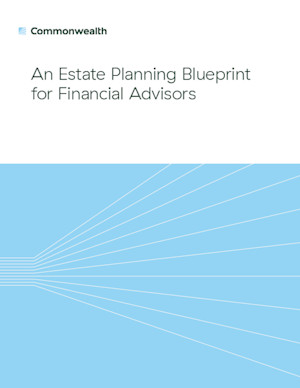Elite advisors know just how important introductions are to the growth of their practice, and so they are very intentional about asking for them. Add in the fact that high-net-worth (HNW) people prefer to be introduced to their advisor by someone they trust, and you can see why, if there’s one skill to master for production growth, it’s gaining introductions to high-quality prospects.
Thinking about breaking away? Get the tools to help you with everything from growing existing client assets to building your brand identity in the Commonwealth Guide to Independence.
So, how do you become proficient at this important skill? Let’s look at four common questions advisors ask about getting referrals, along with solutions for overcoming perceived challenges.
1) Do I Really Need to Do This?
Yes. You should talk to your clients regularly about the people you help and the problems you solve. But don’t just ask for referrals; seek introductions. Getting a prospect’s name as a referral is only the beginning of a slow client acquisition process, and its value can be ambiguous. So, be clear about what you want and ask to be introduced to someone specific.
2) Why Don’t My Best Clients Introduce Me to Others or Give Referrals?
Over the years, many advisors have called me to discuss why their long-term HNW clients rarely, if ever, give referrals—and what they can do about it. I’ve always pushed advisors to go back to their clients and ask. By doing so, I’ve learned something surprising: The best clients weren’t referring prospects because they didn’t know their advisor was open to taking on more clients. They assumed their busy advisor was at capacity.
Could this be the case with you as well? If you haven’t specifically told your clients that you’re looking to add new clients to the practice, they probably don’t know. Priority one should be making sure they’re aware that you have capacity to take on new clients. Here are a few simple ways to let them know you’re interested in client acquisition:
-
Tell clients, simply and directly.
-
Add a bullet point to client agendas.
-
Add a line to your e-mail signature.
-
Train staff on what to say to clients.
Of course, you’ll need to find what works for you. Just be sure to keep it top of mind; otherwise, you’ll find yourself reflecting on missed revenue opportunities.
3) How Can Asking for Introductions Feel Easier and More Comfortable?
According to the Economics of Loyalty, when asked about referrals, clients said they usually resulted from a conversation with a friend or colleague—not with the advisor. In other words, clients don’t give referrals to help you; they give them to help other people (see accompanying chart). This should feel tremendously freeing for most advisors because you won’t be asking someone to help you grow your business. Instead, you’re letting clients be the hero by suggesting that working with you could help someone they care about.
| Reasons for Making a Referral | ||
|
My advisor told me they were interested in referrals and I provided a name at that time. 6% |
A friend or colleague asked me if I knew a good financial advisor and I made the introduction. 45% |
A friend or colleague told me about a financial challenge they were having and I suggested my advisor might be able to help. 54% |
| Source: Economics of Loyalty, Advisor Impact | ||
Once you understand that referrals or introductions to high-quality prospects come when clients want to help other people, you can start to find the words and situations that will act as a catalyst for people to suggest you. I call these lightbulb moments. Your goal is to ensure that clients leave your office with very specific ideas about who your ideal client is and how they can refer those prospects to you.
If you work with retirees, for example, you could end a client meeting with the following:
Bill, I’m so glad that you have the income you need to live comfortably in retirement. I know that people without a good retirement income plan in place are often worried. The next time you’re golfing at the country club, and you hear friends talking about how low interest rates are hurting their income, remember that I’d be happy to help them for you.
Here, you’ve stated the value that the client has received from working with you; be sure to do that first. You’ve also primed the client to be ready for a specific occasion when he has an opportunity to mention you. In this case, the occasion is a discussion of low interest rates (a fairly common concern among retirees), and the opportunity is at the country club. When Bill goes golfing again and someone complains about interest rates, he will hopefully remember your conversation, and then the lightbulb moment—“you should talk to my advisor”—will occur.
Here’s another example, for business owners:
Sue, I’m glad we set up a retirement plan for your business. Not only will you save thousands in taxes, you and your employees will be able to save for retirement in a tax-efficient way [value]. And having a retirement plan helps you attract and retain good talent. When you’re at the next Chamber of Commerce meeting and you hear business owners complaining that taxes are killing them [occasion], think of me. I’d be happy to be a resource to any of your business colleagues [opportunity].
These examples boil down to letting clients know the people you help and the problems you solve. When you talk about this regularly, clients will better understand who would be a good fit for your practice.
Often, advisors don’t know their ideal client; I hear things like, “older clients with at least $750,000 in investable assets who like to delegate.” That might be true, but it’s virtually impossible to search for and unrealistic to expect clients to find. This exercise might force you to more closely examine your target audience, so you can better explain it to someone else.
4) How Can I Find More Clients Like My Best Clients?
Think virtual! One thing the pandemic has taught us is that geographic proximity isn’t needed to run an effective practice—or attract new clients. More advisors are discovering how easy it is to attract virtual clients and how simple onboarding them can be. In many discussions with advisors, they’ve told me they now realize they were the ones who put obstacles in the path of a virtual relationship, not the client or prospect.
So stop thinking about who lives in town and start thinking about who could benefit from working with you. Your clients might have grown children living in different states that you never connected with; now’s the time. If you have a specific niche you want to grow, virtual webinars and meetings are a great and engaging way to highlight your capabilities with your target group. Leverage technology for efficiency as well as reach, and your message should resonate with your target market.
Track Your Growth
One of the surest signs of growth is a continual stream of new clients. The strategies discussed here for gaining introductions to high-quality prospects are designed to help you achieve just that. But there’s one more thing you need to do: track of your progress.
How many new clients did you add in 2020? How about so far in 2021? Be sure to track this on a regular basis and set goals for new client acquisition. By creating realistic and stretch goals, you’ll help keep introductions top of mind.
Please consult your member firm’s policies and obtain prior approval for any sales ideas or marketing materials you would like to use with clients.

free download
An Estate Planning Blueprint for Financial Advisors
Take the necessary steps to establish and expand your role on estate planning teams and position yourself as one of your clients’ most trusted and essential family wealth advisors.
Editor’s note: This post was originally published in October 2016, but we’ve updated it to bring
you more relevant and timely information.


